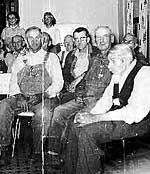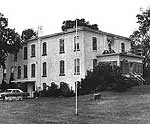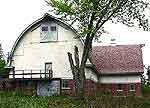By Harry C. Evans
July 29, 2002
These are the opening pages of a report on the cost and conditions of American poorhouses, The American Poorfarm and Its Inmates, published in 1925. The author was Harry C. Evans.
| |
|
|
|
||
The only organization for the relief of the poor in England up to the end of the 15th century was the church. Charitably inclined people made gifts of property to the church for the benefit of the poor.
In the reign of Henry the Eighth, church property was confiscated. Power was centralized in the King. Local government practically disappeared, and with it local responsibility for relief of the poor. The poverty of the country was great. Something had to be done.
In 1601, during Queen Elizabeth's reign, the Government enacted the celebrated Poor Law which imposed a compulsory tax for the maintenance of the poor. This was the first public tax ever levied for that purpose. Prior to that time no distinction was made between the vagrant and vicious poor and the helpless and honest poor. All beggars and vagrants and all who harbored them were severely punished. The penalties included whipping, branding, cropping the ears and hanging.
The new law discriminated between the poor, innocent, sick and diseased people not able to work and such "as be lusty, having their limbs strong enough to labor". The law provided that the former may be "provided, holpen and relieved", while the latter should "be kept in continual labor". Soon England began to build poorhouses.
The Poor law was adopted by the colonists of the New England States and Pennsylvania and is the basis of our poorfarm system of today. The first poorfarm established in North America was at Philadelphia in 1773. It is still flourishing, an ancient and inglorious landmark of that historic city. We are not, however, writing a history of the poorfarm. We hope we are writing its obituary.
| |
|
|
|
||
Two years ago Secretary of Labor, James J. Davis, attended the National Conventions of the Loyal Order of Moose, the American Legion, the American Federation of Labor, the National Fraternal Congress and the American Fraternal Congress. The Secretary stated to each of these conventions that it was his belief that the poorfarms of the United States are badly mismanaged, maintained at exorbitant cost, and that practices of inhumanity and neglect are common.
He invited the organizations above named to join in a study of the poorfarms in every state, county and community, to the end that actual conditions might be determined and possibly some better method of caring for the dependent poor adopted. Each of the conventions approved the plan. The Fraternal Congresses are national organizations, their constituents being the fraternal benefit societies. Several fraternal societies, members of the Congresses, and the Loyal Order of Moose, collaborating with the Department of Labor, began the study.
The Department of Labor took a census of the poorfarms, determined the number of acres set aside for their use, the amount of money invested in them, and the annual cost of maintenance. The fraternal societies, assisted by special examiners from the Department of Labor, by personal visits to the poorfarms, determined the actual conditions of life surrounding the institutional paupers of the country.
The writer was appointed by Secretary Davis the fraternal Congresses and the Loyal Order of Moose to direct the work. The result is believed to be the most elaborate study yet made of the poorfarms of the United States and their inmates.
The story of the American poorfarm and its paupers has been told piecemeal. Here and there a state has made inspections and published its findings, the National Committee for Mental Hygiene has scored deeply as it has encountered the poorfarm in its research work; the Children’s Bureau at Washington has entered complaint that contact with the poorfarm is polluting children; now and then some writer has denounced the impossible living conditions at the farms, and the inhumane treatment of inmates.
|
"The poorfarms of the United States have no justification for their existence; the entire system should be uprooted and abolished. "
- Harry C. Evans, author of 1925 report on conditions at poorfarms |
Never before, however has a detailed report of the wicked waste of the taxpayers money, and the wretched conditions surrounding the lives of our institutional paupers been printed in one report.
There are found between the covers of this book a record of the conditions of the poorfarms of all the states, the amount of money invested in them, the cost of their maintenance, a record of the conditions under which the inmates live, and the authors opinion as to who the American pauper is and why he is.
The conditions at particular poorfarms set out in these reports are but samples of the worst that were found. Conditions at a few poorfarms in each state are given. In many of the states the same miserable conditions prevail in scores of counties and towns not listed. We have reported the worst, but by no means all the worst. There are many farms that are maintained and conducted in as decent a manner as is possible, but decency is rarely possible under the system.
Some states have authority to investigate and report conditions at poorfarms, studies and surveys have occasionally been made by the national committee for Mental Hygiene and other unofficial organizations. All such reports have been drawn upon for information.
In many states every poorfarm was visited for the purpose of this study. A sufficient number in every state was visited to determine general conditions. Local lodges of the various fraternal societies appointed committees to visit the farms. Special examiners were sent into communities that could not be reached by fraternalists.
Conditions reported are those which were prevalent within the past year or two. In some few instances, when gathered from state reports, conditions reported are older than that. Some of the conditions herein reported may have been bettered, some may now be worse.
| |
|
|
|
||
This study was made in the hope and belief that the poorfarm system as now administered may be abolished and some more humane method of caring for dependents adopted.
HARRY C. EVANS.
POORFARMS SHOULD BE ABOLISHED
The poorfarms of the United States have no justification for their existence; the entire system should be uprooted and abolished. We charge these offenses against the poorfarm system:
1. The inhumane practice of setting up a special place or building and labeling it, to which the unfortunate, intelligent poor must go or starve.
2. The poorfarms and their helpless inmates are a part of the political spoils of the community. The superintendent, manager, or overseer of the poor, is usually appointed because he is influential in politics or because he will take the job for less pay than anyone else and not because of his special fitness for the work.
3. The practice of sending hospital cases, the feeble-minded the insane, the deaf and dumb, the blind to poorfarms.
4. The practice of sending paupers to convict camps.
5. The practice of sentencing criminals to poorfarms.
6. The practice of sending children to poorfarms.
7. The lack of intelligent records showing cost of maintenance, value and disposition of crops, conditions of buildings, necessary additions, repairs and improvements, farm and building statistics mental and physical conditions and case history of inmates.
8. The maintenance of poorfarms that are dangerous firetraps.
9. The maintenance of poorfarms that are unsanitary and filthy.
10. The gross neglect of inmates.
11. The release of feeble-minded and contaminating diseased inmates and those having
hereditary diseases, without record of their past or control of their future.
12. The contract system under which the keep of paupers is let to the lowest bidder.
13. The expensive practice of maintaining scores of poorfarms in a state when one would
render more efficient, more economical, more scientific service.
EXCERPT FROM REPORT ON MINNESOTA
The average investment per pauper in poorfarms is $2,351; in farms having ten or less inmates, $4,726. The average annual cost per pauper is $491; in farms having 10 or less inmates $718. There are over 2,000 idle acres of poorfarm land. A total of $2,424,264 is invested in 44 poorfarms, with an annual cost of maintenance of $505,998.
While conditions are extremely bad in places, generally conditions are above the average. Little effort is made anywhere to afford inmates recreation or religious services. Contaminating diseased inmates and feeble- minded are not segregated. No examinations of inmates are made.
AITKIN-Building unclean and unsanitary. Made-over farm building, old and unsanitary.
ANOCA (sic) -Poor food and clothing; oil lamps; stove; no recreation, music or religious services; diseased persons use common toilets and bath room, and their clothes go in common wash; men and women inmates associate freely and sleep in adjoining rooms; made-over farm building; bedding unclean; vermin; bedrooms dirty overcrowded; toilets dirty and dangerous; dining room unclean; well water, cesspool.
BLUE EARTH-All inmates, men and women, diseased, epileptic, feeble-minded associate together, using common toilets, tubs and wash; building not fireproof; no fire escapes; 18 inmates sleep on the top floor; well, cesspool; convicts work on farm.
DAKOTA-"Worst in state". windows without shades, filthy beds, linen not changed for weeks, vermin; toilets filthy, unsanitary; clothes unclean; common bath; no segregation; stoves, well; two women sleeping in toilet room; nauseating odors.
HUBBARD-Food insufficient; poor beds; vermin; lamps; poor well; open sewer.
KOOCHICHING--In bad repair; out of order; unclean, unsanitary; vermin heating, water and light bad.
MOWER-Two cases of cancer not segregated; sexes not segregated; sleep on same floor; well- cesspool; one marriage between inmates.
MURRAY-Unclean and unsanitary.
ST. LOUIS--Four-story congested, unclean building; danger from fire; bad well water, not enough to flush closets; cesspool; diseased inmates using common bedroom, toilets and tubs; 30 cases of cancer in two years not segregated; one 12-year old child; vermin. Of the 190 inmates, 150 are foreign born.
WILKIN- No recreation or church service. Men and women use same toilet; sleep on same floor; made over farm building; no running water; no bath room; outdoor privy used by both sexes; stoves; well water; no sewerage.
The report examines conditions in several other states. Read excerpts:



